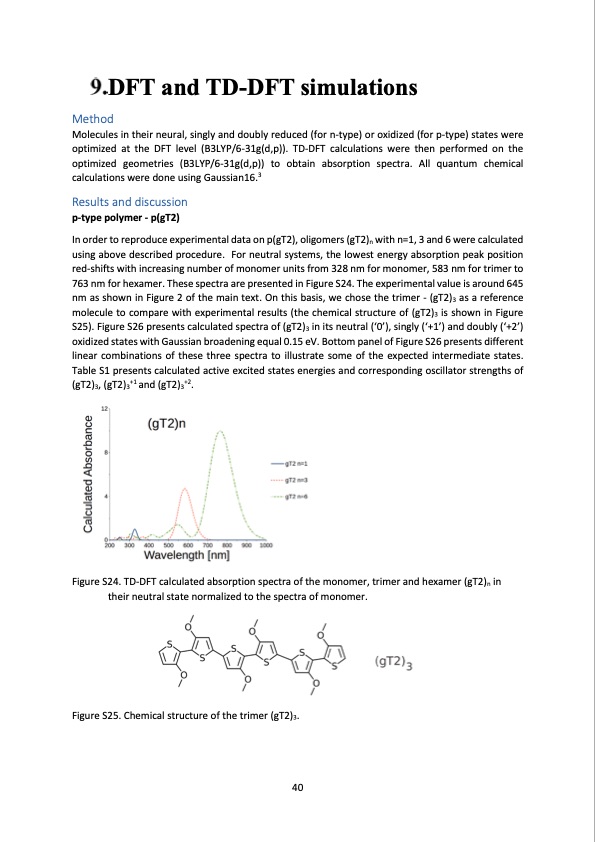
PDF Publication Title:
Text from PDF Page: 040
DFT and TD-DFT simulations Method Molecules in their neural, singly and doubly reduced (for n-type) or oxidized (for p-type) states were optimized at the DFT level (B3LYP/6-31g(d,p)). TD-DFT calculations were then performed on the optimized geometries (B3LYP/6-31g(d,p)) to obtain absorption spectra. All quantum chemical calculations were done using Gaussian16.3 Results and discussion p-type polymer - p(gT2) In order to reproduce experimental data on p(gT2), oligomers (gT2)n with n=1, 3 and 6 were calculated using above described procedure. For neutral systems, the lowest energy absorption peak position red-shifts with increasing number of monomer units from 328 nm for monomer, 583 nm for trimer to 763 nm for hexamer. These spectra are presented in Figure S24. The experimental value is around 645 nm as shown in Figure 2 of the main text. On this basis, we chose the trimer - (gT2)3 as a reference molecule to compare with experimental results (the chemical structure of (gT2)3 is shown in Figure S25). Figure S26 presents calculated spectra of (gT2)3 in its neutral (‘0’), singly (‘+1’) and doubly (‘+2’) oxidized states with Gaussian broadening equal 0.15 eV. Bottom panel of Figure S26 presents different linear combinations of these three spectra to illustrate some of the expected intermediate states. Table S1 presents calculated active excited states energies and corresponding oscillator strengths of (gT2)3, (gT2)3+1 and (gT2)3+2. Figure S24. TD-DFT calculated absorption spectra of the monomer, trimer and hexamer (gT2)n in their neutral state normalized to the spectra of monomer. Figure S25. Chemical structure of the trimer (gT2)3. 40PDF Image | salt water battery with high stability

PDF Search Title:
salt water battery with high stabilityOriginal File Name Searched:
salt-water-battery.pdfDIY PDF Search: Google It | Yahoo | Bing
Product and Development Focus for Salgenx
Redox Flow Battery Technology: With the advent of the new USA tax credits for producing and selling batteries ($35/kW) we are focussing on a simple flow battery using shipping containers as the modular electrolyte storage units with tax credits up to $140,000 per system. Our main focus is on the salt battery. This battery can be used for both thermal and electrical storage applications. We call it the Cogeneration Battery or Cogen Battery. One project is converting salt (brine) based water conditioners to simultaneously produce power. In addition, there are many opportunities to extract Lithium from brine (salt lakes, groundwater, and producer water).Salt water or brine are huge sources for lithium. Most of the worlds lithium is acquired from a brine source. It's even in seawater in a low concentration. Brine is also a byproduct of huge powerplants, which can now use that as an electrolyte and a huge flow battery (which allows storage at the source).We welcome any business and equipment inquiries, as well as licensing our flow battery manufacturing.| CONTACT TEL: 608-238-6001 Email: greg@salgenx.com | RSS | AMP |